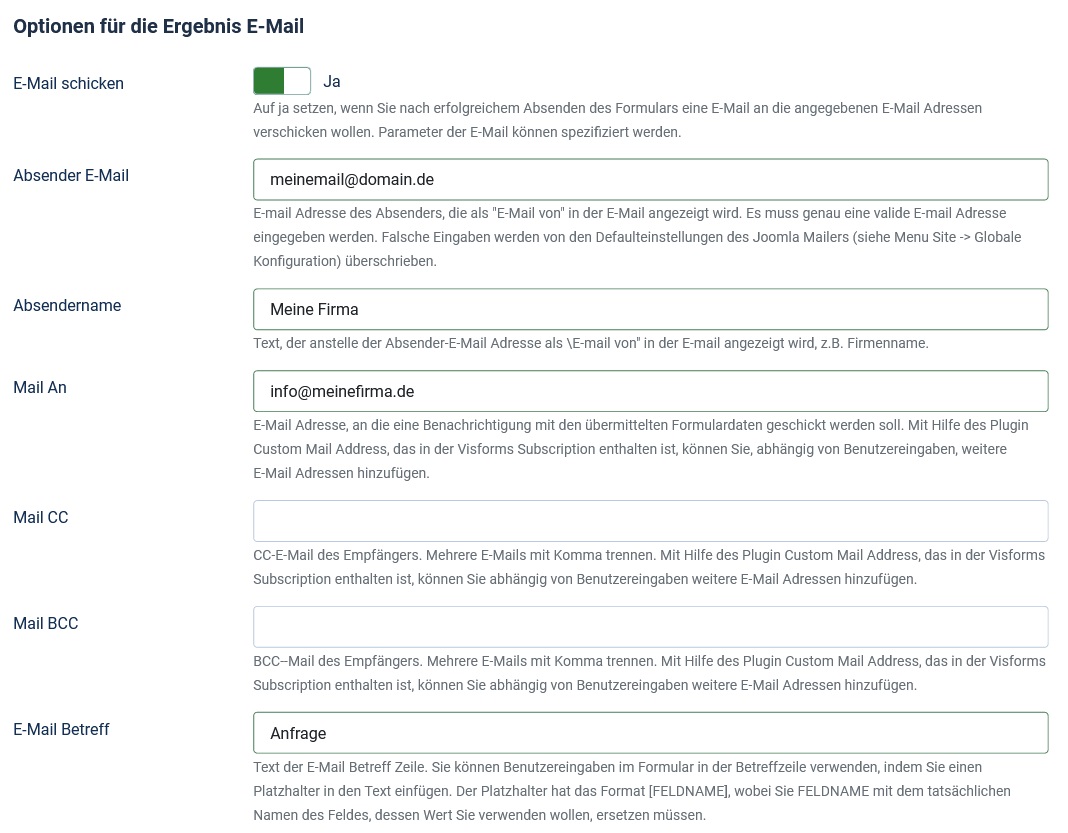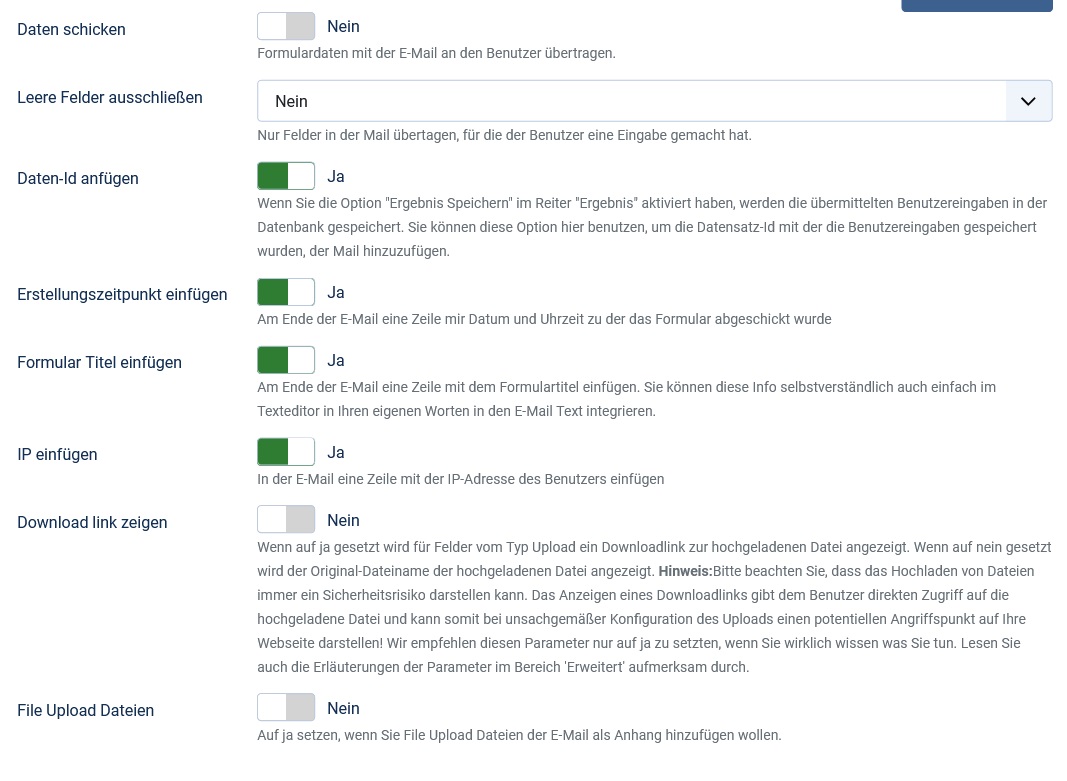Result mail to you (admin) and user mail
You can send a result mail for you (administrator) and a user mail for the website user. A user email can only be sent if the form contains an email field and the user has entered a valid email address there.
Shipping is disabled by default
The sending of emails is deactivated by default. You must first provide some required information so that Visforms can send emails. Then activate the email dispatch. This is done in the form configuration on the “Mail Options” tab.
Design and control each email recipient type separately
There is a full set of result mail options under Result Mail Options and a full set of user mail options under Email to Your Website User Options. Each email type can thus be designed and controlled individually.
The options are divided into two areas:
- Options to control email sending
- Options to control message content
Options to control email sending
Result mail

User mail

Options for controlling the email dispatch can be found above the “Result Mail Text”/“User Mail Text” editor input field.
Set the option Send email to “yes” if you want to send an email of the respective type.
Required fields
In order for Visforms to be able to send a result email or a user email, you must first enter a Sender email address and a Recipient email address.
Sender address
Enter the sender email address in the Sender email option. Please note that the domain part of the sender email address should always correspond to the domain of the website. Emails sent from a website are subject to particularly strict monitoring with regard to spam. Matching the domain is an important criterion here.
Recipient address
Enter the recipient email address in the Mail To option. You can store exactly one recipient email address. In the case of user mail, the recipient email address is automatically taken from the data that the user entered in the form. If there are multiple email fields on your form, the user input from the first filled-in email field will be used.
Additional information
You should also enter a Sender Name (e.g. your company name) and an Email Subject. You can also use user input from the form in the subject. Simply add a field placeholder to the subject text. This is automatically replaced with the value that the user entered in the appropriate field on the form.
The placeholder has the following format:
- open square brackets,
- name of the form field (option Name from the field configuration) in capital letters,
- close square brackets.
For example [FIRSTNAME] for the user input in the field with the name firstname.
Result mail
CC and BCC
If required, you can send the result mail to additional recipients via “CC” (Carbon Copy) or “BCC” (Blind Carbon Copy). In the options Mail CC and Mail BCC you can also enter more than one email address. In this case, please separate email addresses with a comma.
Reply address from the email field
Visforms automatically adds a reply address to the result mail (to the administrator) if the form has an email field and the user has entered an email address there. This reply address is used if you use the “reply” functionality of your email program to reply to the result email. The response is then automatically addressed to the form user’s email address.
User mail
Reply address from the email field
Visforms automatically adds a reply address to the user mail (to the user) if the form has an email field and the user has entered an email address there. This reply address is used if you use the “reply” functionality of your email program to reply to the result email. The response is then automatically addressed to the form user’s email address.
An individual reply address in connection with the correct domain-specific sender address is what is usually used and expected. In addition, it is possible to insert the reply address as a placeholder in the email subject.
Sender address from the configuration
Visforms deliberately prevents the address from the email field of the form from being used as the ‘From address’.
Look again at the section Mandatory fields: Sender’s address further up on this page.
Options to control message content
Result mail

User mail

User input in message body
Visforms offers you a bundle of options with which you can easily, quickly and clearly integrate the transmitted user input into the message content. You will find these options below the “Result Mail Text”/“User Mail Text” editor input field.
The Insert Data ID, Insert Creation Time, Insert Form Title and Insert IP options allow you to choose whether or not to automatically insert this important information into the body of the message.
Using the two options Send data and Exclude empty fields, you can easily integrate the transmitted data into the message text.
Option: send data
If this option is activated, Visforms adds a line to the message content for each form field. The user input of the respective field is displayed in the format “Field label: User input” per line. If a user has not entered a field in the form, only the label is displayed.
Option: Exclude empty fields
If this option is activated, then all rows with fields that remained empty in the form will be suppressed in the listing generated by the Submit data option. These are both conditional fields that are not visible due to the user’s input on the form, and fields that contain no input. Please note that fields containing the value 0 will still be listed.
User mail address as link (result mail only)
If the body of an email contains a clickable linked email address, this increases the risk of an email being blocked as spam. We therefore recommend disabling this option. If this option is activated, then Visforms inserts all entries made in email fields as clickable email addresses.
File Upload Files
If your form has fields that allow the user to upload files, then you can enable the File Upload Files option. In this case, the uploaded files will be sent as an email attachment.
Show Download Link (User Mail Only)
If this option is activated, a link to the uploaded file is inserted for fields of the “File upload” type.
Exclude fields in data listing
The ability to set the field configuration to exclude a field in the mail’s data listing completes the simple and fast configuration of user input in the message content. You can find these options in the field configuration on the “Advanced” tab and can use them to exclude any field from the data listing individually.
Individually styled emails
Two editors
If you control the message content using the above options, you have little control over the appearance of the message content. For example, you cannot use highlights, affect order, or set line spacing. That’s why Visforms also offers the option of completely customizing the message content of mails. This is done via the editor Result Mail Text or User E-Mail Text.
Any text & placeholder
You can enter any individual text (including images and links) for the mail here and design it using the editor controls. Use the “Visforms Fields” editor button to insert placeholders for the user input in the form anywhere in the text. These placeholders are replaced with the entries that the user made in the form. More on this in: Data in emails and success message.
Of course, you can combine all options for easy and quick configuration of the message content with an individual message text. This way you will get the best result.
Additional features of the Visforms Subscription
The Visforms Subscription also offers you some advanced email features:
- Define different field labels to be used for automated data listing in mails</ a>.
- Send result mail to different email addresses depending on input the user has made in the form.
- You can define email attachments.
Problems sending emails
Emails that don’t arrive as expected are the most obvious place when something isn’t working correctly. When something doesn’t work somewhere in the entire form submission process. Or if there is something wrong with the Joomla installation itself.
Within Visforms, sending emails is a very stable and bug-free functionality. Many problems related to sending and receiving emails have causes that are not directly related to Visforms.
Numerous players
There really are a lot of players involved in the email sending workflow. These are in particular:
- Joomla itself,
- the webmailer used,
- the email provider,
- the email client,
- IP black lists and
- various spam filters.
It is often the configuration of these players that is responsible for email not arriving as expected. These areas are not part of the Visforms code. They are the responsibility of the respective administrator.
Checklist
Note: Please go through the following checklist if you have problems sending emails.
- Make sure you understand and correctly set all email sending configuration settings.
- Check that the form submission works.
Set the “Save data” option for the form to “yes”.
More on this in: Saving and using data.
When submitting the form works correctly, a record is now saved in the data table each time.
If saving the data does not work, then the problem is not with the email, but earlier. - Make sure the mailer exists on your system and is configured correctly.
Visforms uses the Joomla! Mailer to send your mails. - Actively test the function of the mailer with another Joomla functionality, e.g. when registering as a user.
Blocked as spam
If all the above tests are positive, then the problem is usually because the emails are being blocked as spam. We continuously strive to design the emails generated by Visforms in such a way that they meet the standards. Please also note the relevant information in the descriptions of some email options.
Therefore, the reason why the emails are blocked as spam is usually not due to Visforms. It is much more due to the server configuration or firewall settings of the receiving email system, for example. In this case, please contact your provider.
Spam filters with points system
Many providers use email spam filters that work according to a points system. There is a set of filters and each filter is associated with a number of counting points. If the total number of points calculated by all filters for an email is above a threshold, then the email is considered spam and blocked.
High points through “ReplyTo” header
We have learned that some spam filters give high points if a freemail address is included in the “ReplyTo” header. So if a user with a freemail account (Gmail, freemail, etc.) fills out the form, the limit will be exceeded and the resulting mail will be blocked as spam. You can usually configure this limit yourself. In this case, it can therefore make sense to set the limit value a little higher (e.g. from the default value of 5 to 6).